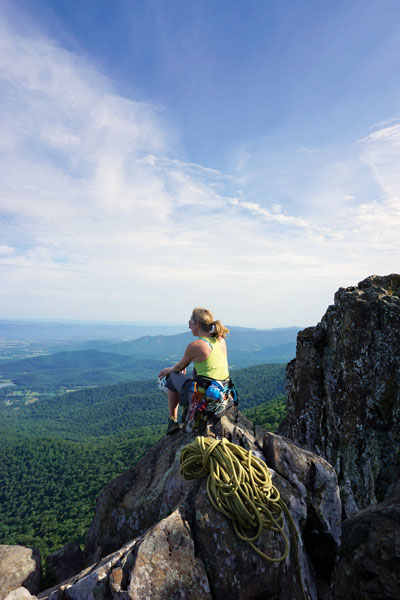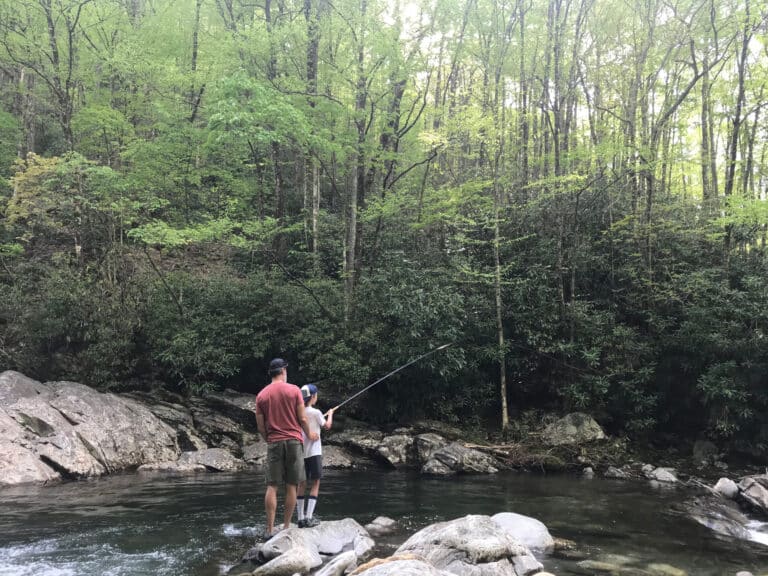I reach up with my right hand and slip a tooth-sized aluminum nut into a crack running through the greenstone rocks of Little Stony Man—a cliff outcrop in Shenandoah National Park. This miniscule piece of metal and a rope are all that protect me from a 20-foot drop to a ledge below.
Bird droppings speckle the only holds available for my hesitant hands. I wonder if this is a nesting site for a peregrine falcon and whether, with my presence, I’m disturbing a natural process.
Climbing is becoming more popular. The number of rock gyms has nearly tripled in the past twenty years, and even more people are venturing outdoors to get their hands on real rock. How will that affect our crags and cliffs?
As someone who practices what is known as clean climbing, where everything that I bring in for a climb comes back out with me, I often think about the influence I have on the vertical world. The clean climbing revolution started in the 1970s when climbers realized the pitons they were pounding into the rock were permanently damaging it. Neil Arsenault, a local climbing guru, was a leader of that revolution.
“The biggest thing I don’t understand is the direction that climbing is going in,” he says. “People still look back at the clean climbing revolution of the ‘70s with some sort of nostalgia and moral superiority and say, ‘that revolutionized climbing and changed it forever, and it made climbing better. It protected the environment. But—we are going to bolt stuff anyway.’”
Bolting became popular in the 1990s with the upsurge in sport climbing, which uses bolts drilled into the rock rather than removable gear to secure the climbing rope to the cliff. Nowadays there are climbing areas, like the New River Gorge in West Virginia, that contain thousands of bolts to create routes.
“I don’t think every piece of rock that can be climbed, needs to be climbed,” says Arsenault.
In addition to the disharmony of putting bolts in rock, climbers trample vegetation and disturb bird habitat. Halfway up Little Stony Man, I scrape off grey-green lichens from the side of the cliff so that I can smear my foot against clean rock for a better stance. These curly-edged organisms, composed of algae and fungi, exist in a symbiotic relationship and are an essential contributor to the long-term erosion of rock into soil. They survive in some of the most extreme environments where other species cannot. But driven by an instinct to climb safely, I disrupt an ancient species.
And what about the plants found 90 yards to my left or in the crumbling talus field 50 feet to my right? The Park Service closed these sections in September 2014 after surveys revealed eleven globally rare or entirely endemic plant species in these parts of the park.
Before these areas around Little Stony Man were closed, I had trekked across them, unknowingly disturbing a unique ecosystem, and coming as close as I ever will to an endangered species outside of a zoo—the endangered Shenandoah salamander. This elusive reptile, muddy brown with a burnt orange stripe down its back and about five inches long, lives in the higher elevations of the park, sheltering in rock crevices, forest soils, and talus fields.
The main climbing areas remain open, however, thanks to efforts of the climbing community working in collaboration with the Park Service to develop a Rock Outcrop Management Plan to protect the ecosystem while maintaining access.
“There are so many different stressors to these systems that we never know for sure which one is going to pitch it over the edge,” says Jim Schaberl, chief of natural and cultural resources for Shenandoah National Park. “Our goal is to try and reduce the impact of those stressors, especially those that don’t belong.” It’s a challenging task for the Park Service whose job is to manage both conservation and access on public lands—an often-competing mission.
“I would love for climbers to take upon a certain sense of ownership of climbing areas and approach someone if they are engaging in a practice that
is not a good idea,” says Edwin Bachetti, vice president for the Mid-Atlantic Climbers.
As I top out on my climb at Little Stony Man, the rolling blue hills make me feel insignificant. I know that my influence on nature is small but still very real. My actions need to go beyond Leave No Trace. Some crags should not be climbed. And even the cleanest and most conscientious climbers need to take a more active role in protecting the places where we play.







